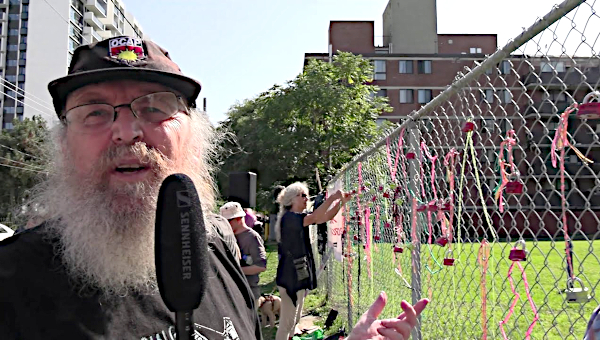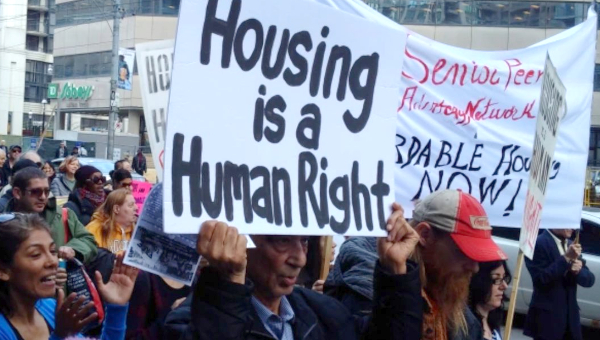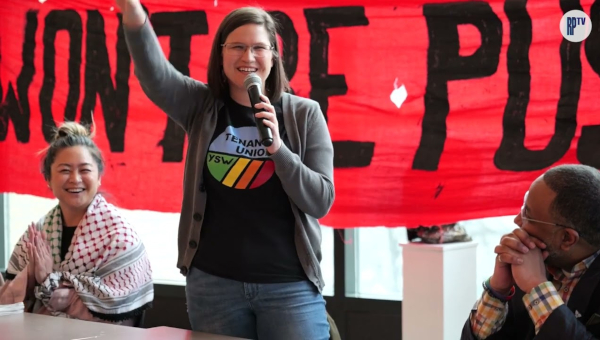Breaking the Cycle or Going Around in Circles?
The Ontario Poverty Reduction Strategy
On December 5th, the Hamilton poverty reduction working group held a meeting on the provincial government’s poverty reduction strategy, which had been released the previous day. Echoing the talking points released by the main Ontario anti-poverty coalition, 25in5, the group took credit for forcing the government to persist with its strategy despite the downturn, welcomed the report as the first hopeful sign for meaningful action on poverty since the Ontario Government Transitions report of 1988, but called on the government to go much further. The upbeat mood was temporarily deflated when NDP (New Democratic Party) MPP Paul Miller, whose condescending tone and dismissive critique made him seem to be on loan from the museum of 1970s social democratic politicians, insisted that the anti-poverty campaigners in the room had been hoodwinked by Liberal smoke-and-mirrors, that there was nothing to celebrate, that the plan would just create more bureaucracy, and that what was needed was a government (presumably led by the NDP) that would cut bigger cheques for the poor.
While Miller’s political tin ear made his words go over like a lead balloon, especially for people who remembered their cheques shrinking under the Bob Rae NDP government of the 1990s, he raised a key strategic question that deserved reflection: what should we make of the McGuinty strategy, and of the 25in5 campaign around it? Is a strategy of positive engagement a wise one for making gains, or will it only deliver thin gruel?
The 25in5 Strategy
The strategy of positive engagement with the McGuinty government’s strategy should be no surprise given the character of the main advocacy vehicle on the file, 25in5. Through the course of the fall, this group grew in confidence and coherence as an important stakeholder in the process. While the tensions I raised in Relay #24 between more liberal-reformist and more social democratic elements remained, the group proved resilient in avoiding splits, and the predictions of some insiders that it would fall apart by November did not come to pass. Part of the reason is the group’s reach and access: for social movement and social policy advocates who have effectively been shut out of Queen’s Park for a generation, 25in5 stands out for its linkages into the bureaucracy and the Premier’s office. As one steering committee member put it, he had never been part of a campaign with so many backchannels into government. He likewise claimed to have never been in a group where the promiscuity of members was so accepted, in the sense of accepting, and even expecting, that members remained free to maintain their own agendas and state linkages separate from 25in5.
In addition to some insider access, the cohesion of the group owes something to its success in keeping poverty on the
provincial agenda, despite a worsening economic situation. While there were indications that poverty reduction would disappear in light of the recession, by October it was clear that there would be some sort of provincial strategy announced by year’s end. Throughout the fall, it was clear that there was tacit cooperation between the Minister responsible for the file, Deb Matthews, and 25in5, where the latter’s polite lobbying and community campaign created some space for the former to bargain with her cabinet colleagues.
In anticipation of the December release of the government’s strategy, the 25in5 coalition sent Ryerson social work
professor Marvyn Novick and the Social Planning Network of Ontario’s Peter Clutterbuck around the province for discussions about a “Blueprint for Poverty Reduction.” The idea was to lay out a concrete set of actions that might achieve the goal of reducing poverty by 25 per cent in 5 years, and to thereby create a set of expectations against which the forthcoming provincial plan could be judged. This included the expectation for a 25in5 target for family and adult poverty as a first step to a 50 in 10 commitment, the adoption of the Low Income Measure as a benchmark, the setting of goals, proposed actions, and monitoring mechanisms in critical areas (e.g. assure all adults working full-year, full-time have an above-poverty standard of living; develop specific measures for racialized communities, Aboriginal peoples, lone mothers and persons with disabilities), the establishment of accountability structures, and the demonstration of a serious commitment to invest in poverty reduction.
Four areas of investment were highlighted: namely making progress on an affordable non-profit early learning and childcare
system-building, an additional 8,000 social housing units per year, supporting community partnerships in poverty reduction as well as core funding community groups doing work with poor people, and measures to improve the adequacy of income security. The latter included a $100/month hunger supplement for social assistance recipients and an enriched Ontario Child Benefit (from $1100 to $1500 per year). The Blueprint argued that $1-billion was a reasonable down-payment, representing what Quebec spent on anti-poverty initiatives (exclusive of childcare) in the first years of its plan. In addition, a series of needed “system changes” were highlighted, included measures to regulate the labour market (higher minimum wages, stricter labour standards), and a revamping of social assistance.
As with its earlier “Pathways to Common Priorities” presentation from the spring of 2008, the Blueprint represented an
interesting social democratic program. It certainly fell well short of a socialist project of increasing capacities for social and economic planning. But it did propose a series of measures that would push poverty reduction beyond the neoliberal budgetary and labour market mantras that framed the government’s Growing Stronger Together consultation paper. Some insiders also see the Blueprint exercise as a maturation of 25in5, to the extent that the actors making up the coalition had to begin to concretize a platform, with the trade-offs and compromises that that requires.
Breaking the Cycle: The Liberal Poverty Reduction Plan
As was foreseeable, the plan unveiled by Minister Matthews was long on good intentions and short on the more substantial measures put forth by 25in5. It did present a long grocery list of initiatives, some already underway, that might squeeze a little extra poverty reduction from existing programs and services. But it put forward little new spending, topping out at about $300-million per year when fully implemented, albeit not counting social housing. This was well short of the modest $1-billion that 25in5 demanded in the Blueprint, or the $2-billion that the Interfaith Social Assistance Review Committee put forward in their pre-budget brief.
There were some points of interest. The government adopted a clear target of reducing poverty by 25% over five years, along with solid measures and indicators for tracking progress, albeit only for child poverty. The plan had the merit of putting more money, albeit in small amounts, into a series of child-focussed programs that centre on health promotion and on marginally reducing class stratification within the school system. It also proposed to increase the Ontario child benefit from $1100 to $1310 per year, and to put money into a Community Opportunities Fund to support local anti-poverty partnerships.
What was missing? The list is too long to summarize here, but a few absences were glaring. First, the emphasis on child poverty left the whole issue of adult poverty on the sidelines, as if children can be pulled out of poor families and communities, and lifted out of poverty through child tax credits. The child focus turns attention away from the economic and political forces (read capitalism) that create enduring patterns of inequality within and between communities. Indeed, the rationales for poverty reduction presented are highly liberal: equality of opportunity for children to succeed on the one hand, and producing a high-end competitive workforce on the other.
The failure to confront structural causes could also be seen in its non-engagement with issues of race and gender. For instance, there was no response to the demands of the Colour of Poverty coalition for action on employment equity, anti-racism, public sector hiring diversity and an equitable and inclusive educational curriculum. Beyond a $200 enrichment of the child benefit (from $1100 to $1300/year), there was nothing to ensure liveable incomes, particularly for adults on social assistance or disability. Indeed, beyond a promise to undertake a year-long review of the social assistance system, there was no sign of a concerted plan to improve the quality of life and life chances of recipients. It was a poverty reduction plan without redistribution.
The plan’s neoliberal orthodoxy of not encumbering public finances with significant new costs was matched in its
refusal to challenge the deregulation of labour markets. Again, measures that might allow workers to earn living wages, and thus eliminate in-work poverty, were missing. Not surprisingly, making it easier for workers to form unions, even in the weakest form of returning to card-check certification, was not on the agenda. But even the promises to improve the enforcement of labour standards and to more strictly regulate temp agencies, while important, do more to actualize and enforce existing rights for workers, than to challenge non-standard employment and low wages. Limiting the worst abuses does little to create labour markets providing high and sustainable standards of living.
Why the friendly response?
The 25in5 response was one of “constructive engagement.” It welcomed the report, and particularly its selection of a 25in5 target, the identification of specific
initiatives to reach it, the use of the Low Income Measure, and the development of accountability and monitoring mechanisms.
It also welcomed the fact that social housing would be part of the government’s upcoming ten year, $60-billion infrastructure plan, but stuck to the demand for 8000 new units annually, and called for an extension of housing benefits to all low-income people. Similarly, it tipped its hat to the government’s proposals on early learning and labour markets, but called for more substantial plans on the former front, and for a Good Jobs Strategy on the latter. It was more critical of the child focus, calling for an extension to the whole population as progress is made with child poverty. It also deplored the lack of any mention of racialized communities.
One reading of the supportive response to such a modest program would return to the earlier comment of back channels, and
note how central players in 25in5 “got paid” in the plan. The child focus and initiatives played to Campaign 2000 and child poverty groups, the promised review of social assistance played to John Stapleton’s recent advocacy, the money for community partnerships would please the social planning councils, the proposed oversight bodies would obviously be likely to recruit their community representatives from 25in5’s inner circle.
This reading is too cynical, even if instructive in some regards. It ignores how far expectations have been lowered under neoliberalism, such that any social investment comes to look pretty good, especially for organizations that have not had much in the way of policy wins for two decades. More importantly, it ignores how the inside circle of 25in5 has positioned the organization as one of dialogue with the state. In this light, a vigorous critique of the proposals would undermine the positive linkages with the bureaucracy and senior Liberal government advisors. There is an expectation that some of the sectors and organizations that did not get anything in the announcement, such as those grouped in the Colour of Poverty initiative, women’s organizations, and social assistance recipients, will break away and mount their own campaigns. In other words, while some of the 25in5 inner circle are more than happy with Matthews’ small package, others are hoping that a renewed push by those left out of the plan coupled with continued insider access for 25in5 may procure further gains.
This inside-outside strategy is not without merit, but depends on the capacity of relatively resource-poor organizations to
maintain a level of mobilization in the face of a disappointing report. For instance, the Social Planning Network of Ontario has worked hard with different local organizations to create pressure for reform in communities right across the province. The consultations and meetings put on by these groups often produced strong demands for improvements to social assistance, particularly of benefits enhancement. This was reflected in the $100 per month hunger allowance in the Blueprint, but there is every indication that the province has no appetite for increasing benefits beyond minor cost of living adjustments. In a best case scenario, these groups will continue to organize and make demands. But it is equally possible that the local organizations will be demoralized by the lack of results (and by the upbeat 25in5 response), ultimately reducing 25in5’s leverage on the inside. More generally, the ability to work an insider/outsider strategy is hindered by 25in5’s lack of transparency and internal democracy. Without a clearly defined and accountable leadership, it is hard for the “outsiders” to coordinate their action with the “insiders,” let alone develop the trust that the “insiders” are not going to sell them out for a handful of magic beans.
What Alternatives?
Developing a strategy at this time is complicated by the economic conjuncture. While a poverty reduction strategy is not radical, it is a manner for ensuring sustained engagement with reducing poverty over the course of years, an engagement where progressive actors can push for investments in social infrastructures that meet needs, but that also increase capacities for democratic planning. It provides a modest way to insist on investment in public infrastructure and public services, such as public housing, public transportation and universal non-profit early childhood education, as well as support for new forms of intervention in public health, education, training and mental health that allow for greater community and user management and participation. It is both understandable and desirable for anti-poverty groups to stand outside the reduction process and criticize its obvious limitations. But this should not come at the expense of attempts to use the strategy as a door into the state for shaping policy and resource allocation. Given the difficulty of sustaining campaigns around poverty, an annual cycle of reports provides some structure for mobilizing and organizing on a recurrent basis.
This is however a long-term strategy, looking ten years into the future (for halving poverty) and beyond (for eradication). As John Clarke notes in his recent Bullet, Ontario’s immediate future is poverty augmentation, as the failure to fix social provision in years of feast (at least for the top 10% of the income distribution) risks great calamity in the coming years of famine. As he notes, municipal reserves for Ontario Works have been spent down, while an already inadequate stock of social housing has been left to deteriorate. An inadequate employment insurance program, on the one hand, and a social assistance system with strict asset limits, on the other, means many of the newly unemployed will have no safety net – they are left adrift between islands.
In such a context, dealing with a slow moving poverty agenda and a fast-moving economic crisis, it may be worth trying to rub the two together. With large fiscal stimulation measures on the horizon, a big struggle will be to ensure that these take the form of public investment, and preferably public investment that enhances the potential for democratic planning. In this struggle, the government’s announced intent to do something about poverty can provide some additional leverage for ensuring investments in poverty-reducing measures such as social housing, community action and early learning and childcare. In other words, it provides a way of pulling the government by the nose toward a public investment strategy. At the same time, the sums being thrown around to stabilize financial institutions and the manufacturing sector make claims of resource scarcity far less persuasive, such that even mainstream anti-poverty organizations can greatly step up the extent of their demands for an acceleration of action on poverty-reduction without squandering their legitimacy.
But if the longer time horizon is one of action plans, annual reports, poverty institutes and stakeholder engagement, it
is also necessary to use the current mobilization to build organizations with the capacity and autonomy to occupy and engage this new part of the state without being co-opted. Particularly at the early stages, shaping these new poverty reduction institutions and processes so as to account for structural understandings of poverty, and to provide access to advocates as well as “neutral experts” will be important. As Alice O’Connor made clear in Poverty Knowledge (2001), a book about the sea of poverty policy research in the United States, if institutions start from the wrong questions, which they tend to do when the ideologies of a capitalist society are left unchallenged, they will yield harmful answers. •
Further Resources
- John Cartwright, “The Rise of Toronto’s Living Wage Campaign” Relay, November, 2007.
- Jacquie Chic, “Anti-Poverty or Anti-Capitalism” Relay, September, 2007.
- Bryan Evans, “Importing Blair’s Failure” Relay, April, 2008.
- Steve Watson, “Fightbacks: Struggling Against Poverty in Ontario” Relay, May, 2007.





